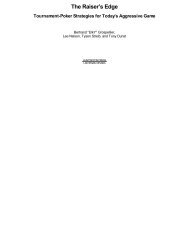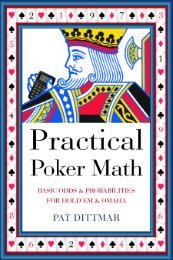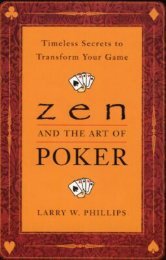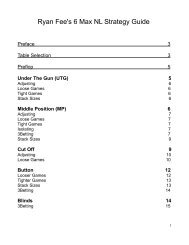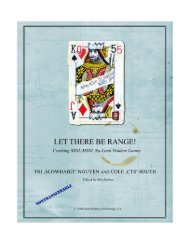You also want an ePaper? Increase the reach of your titles
YUMPU automatically turns print PDFs into web optimized ePapers that Google loves.
109<br />
His pair hands represent 96.5% of his range. If our goal is to not<br />
lose a customer, it’s obvious which bet size we should make. If<br />
we bet $8, we keep our customer every time. Also, if our goal is<br />
to get worse hands to call, we get them all to call with the $8 bet.<br />
However, let’s examine the EV of both of these bets.<br />
The $8 bet gets called 100% of the time, so, the EV of the $8 bet<br />
is $8.<br />
$8(1) = $8<br />
The $500 bet only gets called about 3.5% of the time.<br />
$500(.035) = $17.50<br />
The EV of the $500 bet is $17.50. This is more than double the<br />
EV of the $8 bet even though it’s getting called much less often.<br />
So, in this extreme example, we are better off going for that big<br />
payoff.<br />
Now let’s tweak the example a bit. We’ll give the villain $100<br />
left. Now look at our EV of a $100 bet.<br />
$100(0.035) = $3.50<br />
Here the EV of the $8 bet is more than double the big payoff.<br />
So, when he has $100 left, we’re better off going for the small,<br />
steady payout. But, not every example is this cut and dry.<br />
Much like choosing your bluff sizes, choosing your value bet<br />
sizes can be tricky business. The best way to improve is through<br />
analyzing situations away from the table and getting used to<br />
common situations. <strong>That</strong> way you can quickly recognize those<br />
situations when you come across them and will know what to do.<br />
Now, let’s say villain will always raise with his flush, but still<br />
will always call with his pairs. His raise will be an all-in raise,





